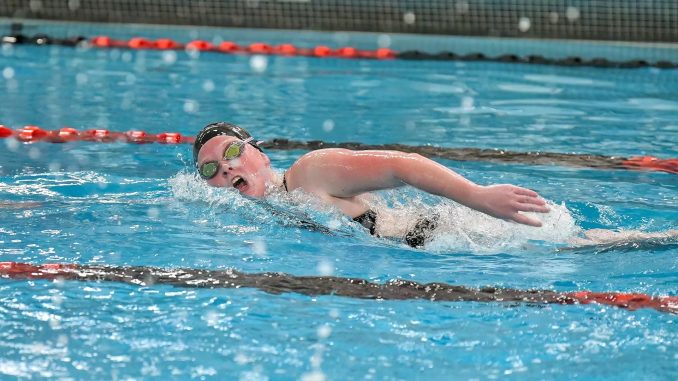
Athletes all around the world experience injuries. In fact, it is considered an inevitability when playing sports. From concussions to ACL tears, injuries are a common experience. Some injuries are minor, resulting in missing little to no competition, and some are major and could be seasonending. For fifth-year senior swimmer Alex Zelinske, an injury could have cost her career.
Her sophomore year of college, Zelinske began experiencing pain in her shoulder. She says, “As a swimmer, my shoulders are constantly sore, especially since I swim backstroke.” But this pain was more severe than soreness. She was told she had a torn labrum and continued swimming through the pain. Eventually her arm turned purple and went numb. This was when she knew she had a real problem.
Zelinske had been misdiagnosed. She actually had thoracic outlet syndrome (TOS). Her coach referred her to a new doctor who took one look at her x-ray and immediately knew what was going on. She tried physical therapy and after a few weeks of seeing no improvement, it was time for surgery. Her case of TOS was too severe. She had an extra rib above her first rib, called a transcervical rib. Her veins, arteries, and nerves were wrapped around it, causing her to lose feeling.
Her surgery was four hours long and consisted of removal of the transcervical rib, the scalene muscles on her left side, and partial removal and elongation of her pectoral minor. When asked about the surgery she said, “It was nerve racking. Finding out I was getting rid of most of the muscles in that area was a scary thought. I was also told that one of the risks was losing all feeling in my arm.” Post-surgery symptoms included phantom symptoms, which were also a shock. She said, “It just felt hollow in there. I felt like I could still feel the pain and numbness even though everything causing the pain was gone. It was a weird feeling for a few weeks.”
Zelinske is suiting up for her final college swim season. She has undergone numerous hours of physical therapy to gain strength and mobility. She definitely notices some changes in her form, but has been working to adapt and learn new skills. Zelinske said, “I cannot do a normal start anymore so I had to readjust my footing on the wall to still give myself the same arc and entry… I’ve also had to readjust my stroke count per lap. Although it was hard, I am still able to give myself the biggest advantage possible without pain.” She is still limited in some aspects and although increasing her time from a 0:58 to 1:03 in the 100 backstroke, she is confident she will be able to get back to where she once was.
As for goals, Zelinske is determined to keep herself in the water and swimming. She was able to have the opportunity to have a fifth season of college swimming and is fortunate to be able to be back in the water. She said, “Whether it is being back to my peak performance or simply finishing every race, I am happy I get the chance to be back in the water again. I’m really focusing on reminding myself why I love swimming.”
Alex Zelinske has made it a personal mission to make her last season count. After being a competitive swimmer for 18 years, she simply was not going to let a diagnosis end her career. Many swimmers do not come back after this kind of surgery, but Zelinske was different. She worked hard and put the time in to regain as much strength as possible. She is fortunate to be able to give one last season to the sport that has given her so much.
